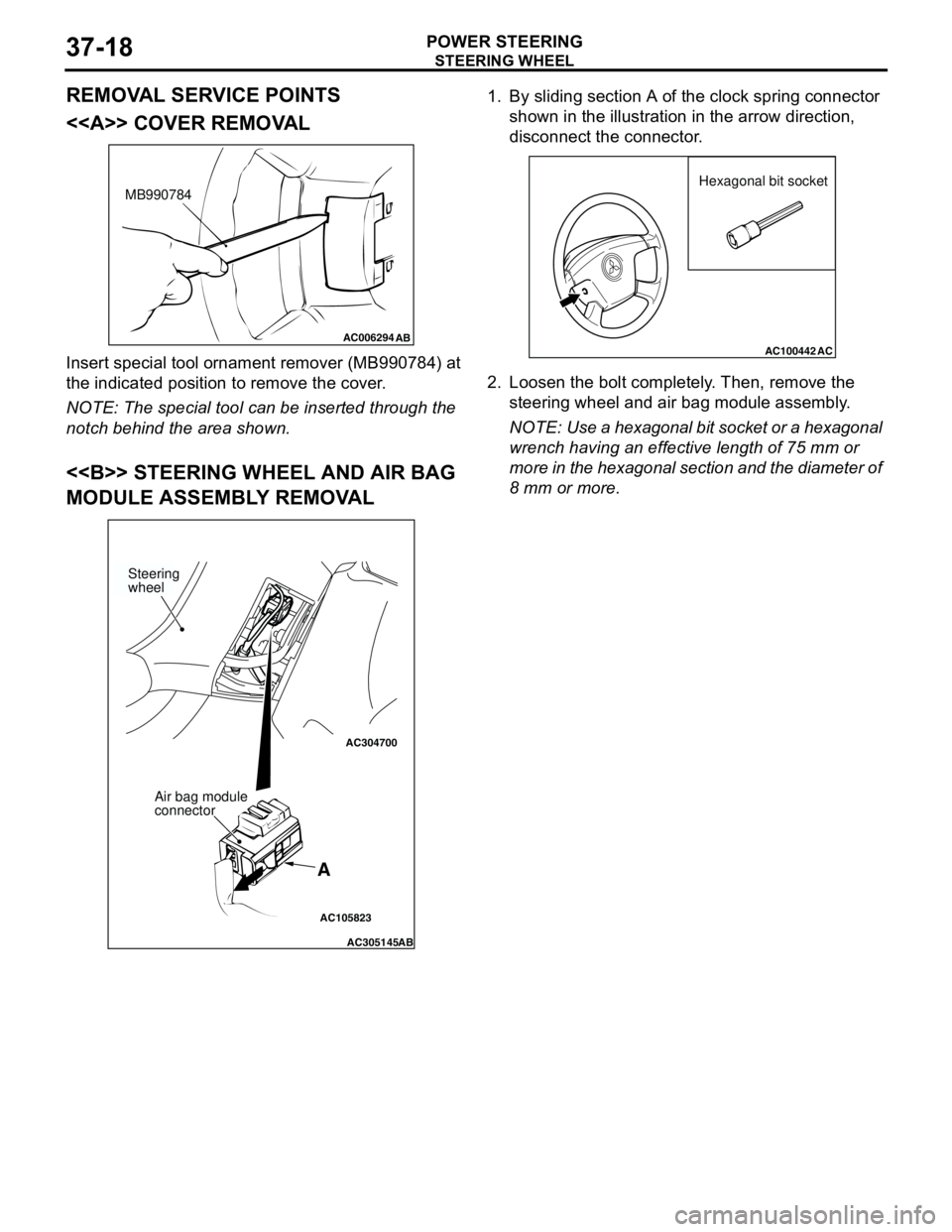direction MITSUBISHI LANCER 2005 User Guide
[x] Cancel search | Manufacturer: MITSUBISHI, Model Year: 2005, Model line: LANCER, Model: MITSUBISHI LANCER 2005Pages: 788, PDF Size: 45.98 MB
Page 198 of 788
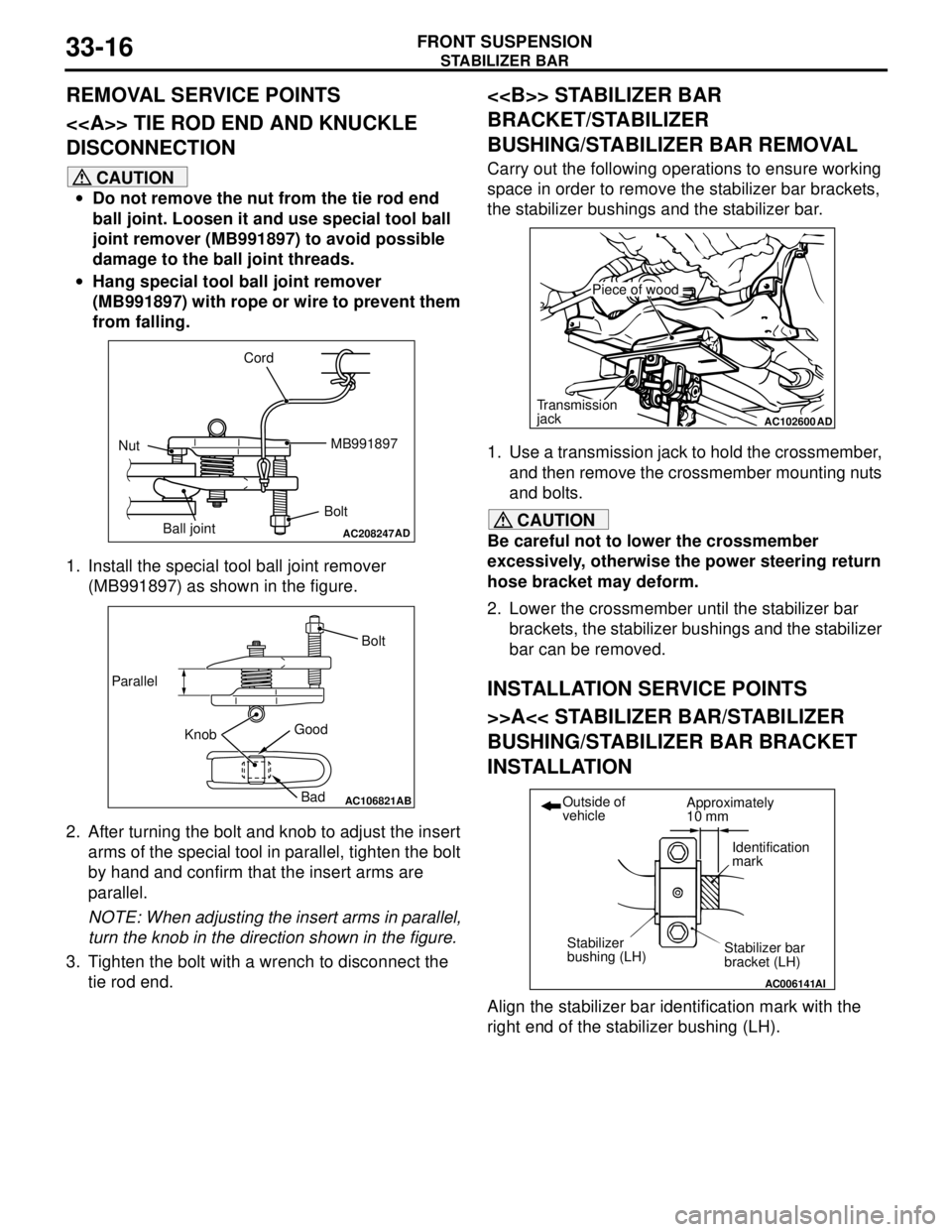
Page 206 of 788
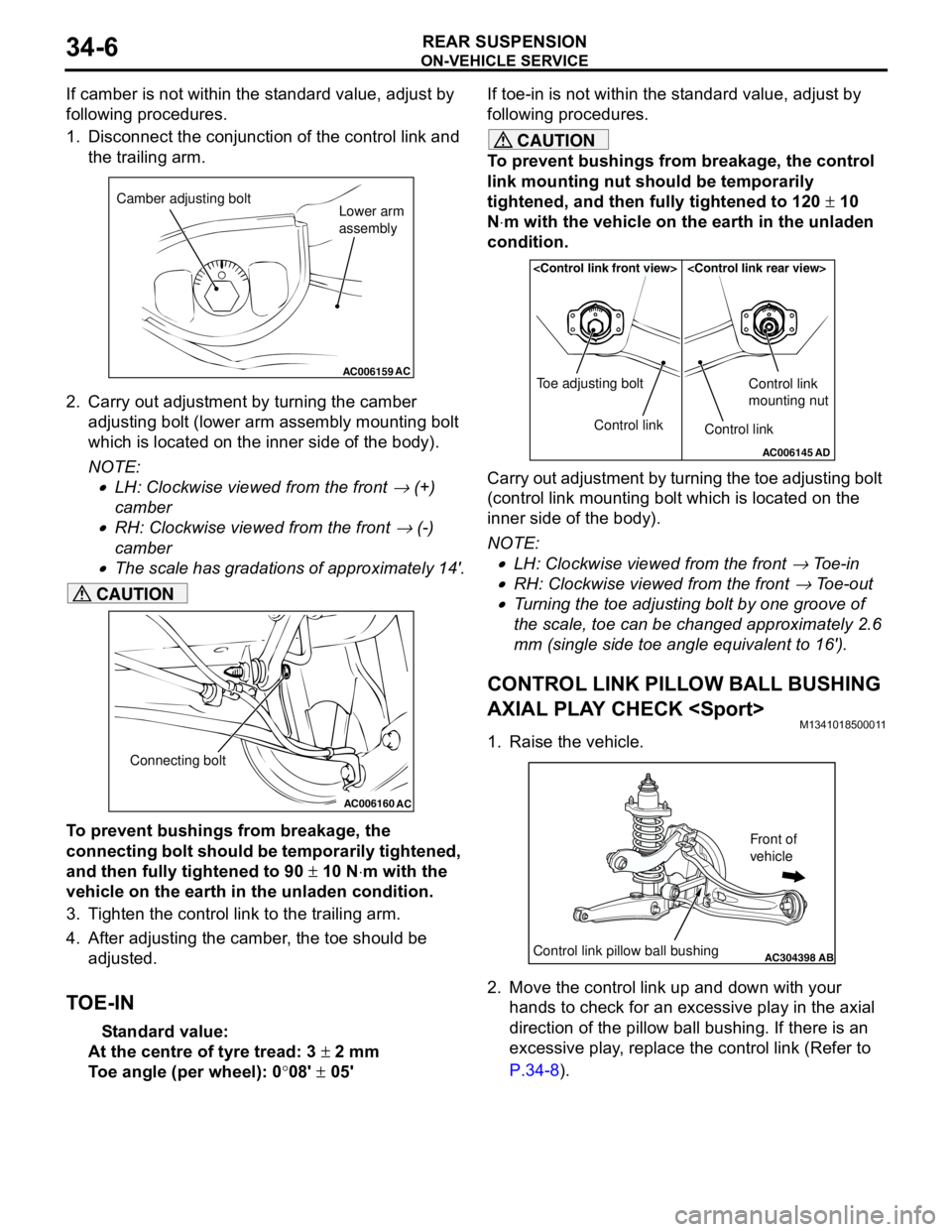
ON-VEHICLE SERVICE
REAR SUSPENSION34-6
If camber is not within the standard value, adjust by
following procedures.
1. Disconnect the conjunction of the control link and
the trailing arm.
2. Carry out adjustment by turning the camber
adjusting bolt (lower arm assembly mounting bolt
which is located on the inner side of the body).
NOTE: .
•LH: Clockwise viewed from the front → (+)
camber
•RH: Clockwise viewed from the front → (-)
camber
•The scale has gradations of approximately 14'.
CAUTION
To prevent bushings from breakage, the
connecting bolt should be temporarily tightened,
and then fully tightened to 90 ± 10 N⋅m with the
vehicle on the earth in the unladen condition.
3. Tighten the control link to the trailing arm.
4. After adjusting the camber, the toe should be
adjusted.
TOE-IN
Standard value:
At the centre of tyre tread: 3 ± 2 mm
Toe angle (per wheel): 0°08' ± 05'If toe-in is not within the standard value, adjust by
following procedures.
CAUTION
To prevent bushings from breakage, the control
link mounting nut should be temporarily
tightened, and then fully tightened to 120 ± 10
N⋅m with the vehicle on the earth in the unladen
condition.
Carry out adjustment by turning the toe adjusting bolt
(control link mounting bolt which is located on the
inner side of the body).
NOTE: .
•LH: Clockwise viewed from the front → Toe-in
•RH: Clockwise viewed from the front → Toe-out
•Turning the toe adjusting bolt by one groove of
the scale, toe can be changed approximately 2.6
mm (single side toe angle equivalent to 16').
CONTROL LINK PILLOW BALL BUSHING
AXIAL PLAY CHECK
M1341018500011
1. Raise the vehicle.
2. Move the control link up and down with your
hands to check for an excessive play in the axial
direction of the pillow ball bushing. If there is an
excessive play, replace the control link (Refer to
P.34-8).
AC006159AC
Camber adjusting bolt
Lower arm
assembly
AC006160
AC
Connecting bolt
AC006145AD
Control link Toe adjusting boltControl link
Control link
mounting nut
AC304398ABControl link pillow ball bushing
Front of
vehicle
Page 207 of 788

ON-VEHICLE SERVICE
REAR SUSPENSION34-7
UPPER ARM PILLOW BALL BUSHING
AXIAL PLAY CHECK
M1341018400014
1. Raise the vehicle.
2. Move the upper arm up and down with your hands
to check for an excessive play in the axial
direction of the pillow ball bushing. If there is an
excessive play, replace the upper arm (Refer to
P.34-8).
LOWER ARM PILLOW BALL BUSHING
AXIAL PLAY CHECK
M1341016900057
1. Raise the vehicle.
2. Remove the stabilizer link and shock absorber
from the lower arm assembly.3. Move the lower arm up and down with your hands
to check for an excessive play in the axial
direction of the pillow ball bushing. If there is an
excessive play, replace the lower arm pillow ball
bushing (Refer to P.34-10).
4. After inspection, install the stabilizer link and
shock absorber to the lower arm assembly (Refer
to P.34-8).
STABILIZER LINK BALL JOINT DUST
COVER INSPECTION
M1341012800274
1. Check stabilizer link ball joint dust covers for
cracks or damage by pushing it with your finger.
2. If a dust cover is cracked or damaged, replace the
stabilizer link assembly.
NOTE: Cracks or damage to the dust cover may
cause damage to the ball joint.
AC304398AC
Upper arm pillow
ball bushing
Front of
vehicle
AC304398ADLower arm pillow ball bushing
Front of
vehicle
Page 210 of 788
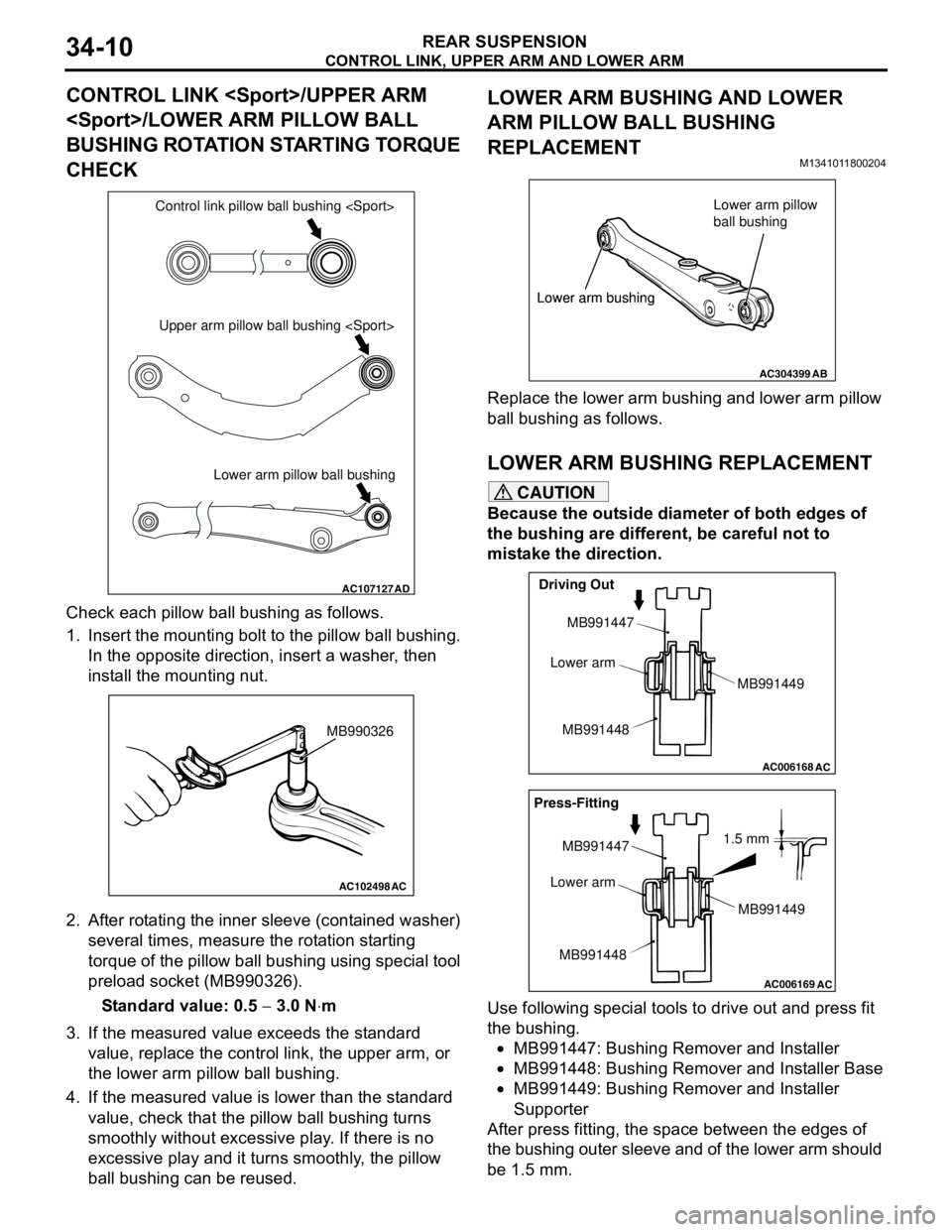
CONTROL LINK, UPPER ARM AND LOWER ARM
REAR SUSPENSION34-10
CONTROL LINK
BUSHING ROTATION STARTING TORQUE
CHECK
Check each pillow ball bushing as follows.
1. Insert the mounting bolt to the pillow ball bushing.
In the opposite direction, insert a washer, then
install the mounting nut.
2. After rotating the inner sleeve (contained washer)
several times, measure the rotation starting
torque of the pillow ball bushing using special tool
preload socket (MB990326).
Standard value: 0.5 − 3.0 N⋅m
3. If the measured value exceeds the standard
value, replace the control link, the upper arm, or
the lower arm pillow ball bushing.
4. If the measured value is lower than the standard
value, check that the pillow ball bushing turns
smoothly without excessive play. If there is no
excessive play and it turns smoothly, the pillow
ball bushing can be reused.
LOWER ARM BUSHING AND LOWER
ARM PILLOW BALL BUSHING
REPLACEMENT
M1341011800204
Replace the lower arm bushing and lower arm pillow
ball bushing as follows.
LOWER ARM BUSHING REPLACEMENT
CAUTION
Because the outside diameter of both edges of
the bushing are different, be careful not to
mistake the direction.
Use following special tools to drive out and press fit
the bushing.
•MB991447: Bushing Remover and Installer
•MB991448: Bushing Remover and Installer Base
•MB991449: Bushing Remover and Installer
Supporter
After press fitting, the space between the edges of
the bushing outer sleeve and of the lower arm should
be 1.5 mm.
AC107127AD
Lower arm pillow ball bushing Upper arm pillow ball bushing
AC102498
AC
MB990326
AC304399AB
Lower arm bushingLower arm pillow
ball bushing
Lower arm bushing
AC006168
AC
Driving Out
MB991447
Lower arm
MB991448MB991449
AC006169
AC
1.5 mm Press-Fitting
MB991447
Lower arm
MB991448MB991449
Page 214 of 788
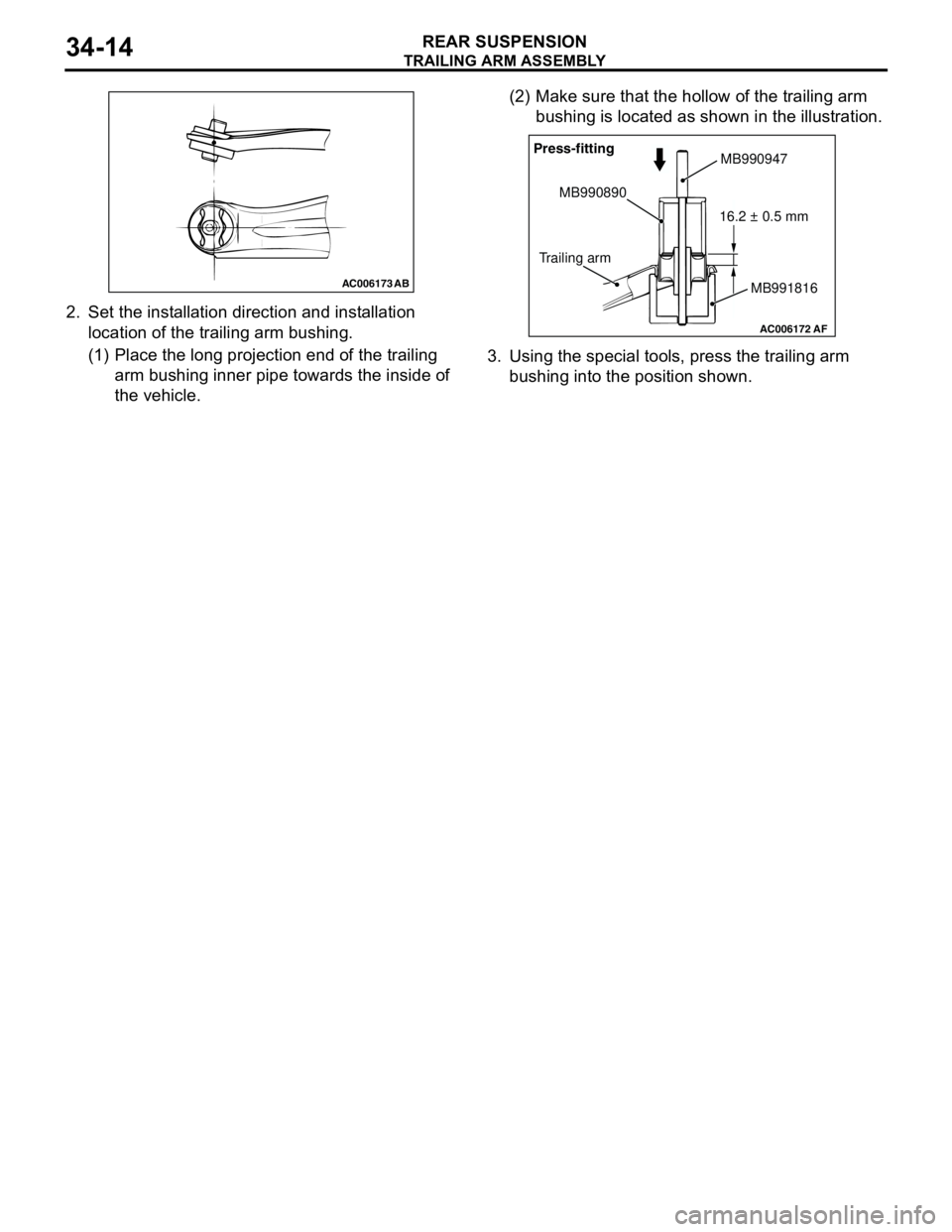
TRAILING ARM ASSEMBLY
REAR SUSPENSION34-14
2. Set the installation direction and installation
location of the trailing arm bushing.
(1) Place the long projection end of the trailing
arm bushing inner pipe towards the inside of
the vehicle.(2) Make sure that the hollow of the trailing arm
bushing is located as shown in the illustration.
3. Using the special tools, press the trailing arm
bushing into the position shown.
AC006173 AB
AC006172AF
Press-fitting
MB990890
Trailing armMB990947
MB991816 16.2 ± 0.5 mm
Page 227 of 788
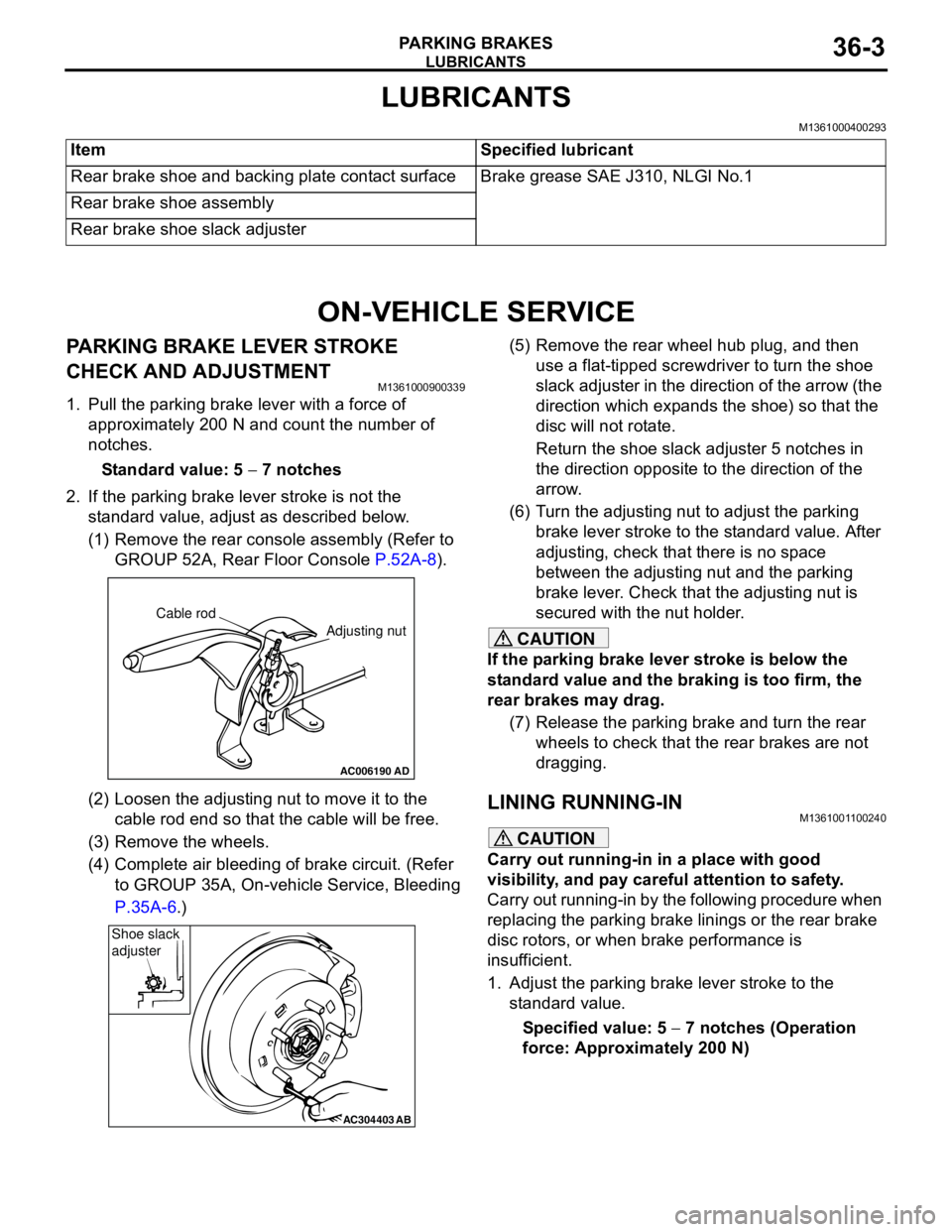
LUBRICANTS
PARKING BRAKES36-3
LUBRICANTS
M1361000400293
ON-VEHICLE SERVICE
PARKING BRAKE LEVER STROKE
CHECK AND ADJUSTMENT
M1361000900339
1. Pull the parking brake lever with a force of
approximately 200 N and count the number of
notches.
Standard value: 5 − 7 notches
2. If the parking brake lever stroke is not the
standard value, adjust as described below.
(1) Remove the rear console assembly (Refer to
GROUP 52A, Rear Floor Console P.52A-8).
(2) Loosen the adjusting nut to move it to the
cable rod end so that the cable will be free.
(3) Remove the wheels.
(4) Complete air bleeding of brake circuit. (Refer
to GROUP 35A, On-vehicle Service, Bleeding
P.35A-6.)(5) Remove the rear wheel hub plug, and then
use a flat-tipped screwdriver to turn the shoe
slack adjuster in the direction of the arrow (the
direction which expands the shoe) so that the
disc will not rotate.
Return the shoe slack adjuster 5 notches in
the direction opposite to the direction of the
arrow.
(6) Turn the adjusting nut to adjust the parking
brake lever stroke to the standard value. After
adjusting, check that there is no space
between the adjusting nut and the parking
brake lever. Check that the adjusting nut is
secured with the nut holder.
CAUTION
If the parking brake lever stroke is below the
standard value and the braking is too firm, the
rear brakes may drag.
(7) Release the parking brake and turn the rear
wheels to check that the rear brakes are not
dragging.
LINING RUNNING-INM1361001100240
CAUTION
Carry out running-in in a place with good
visibility, and pay careful attention to safety.
Carry out running-in by the following procedure when
replacing the parking brake linings or the rear brake
disc rotors, or when brake performance is
insufficient.
1. Adjust the parking brake lever stroke to the
standard value.
Specified value: 5 − 7 notches (Operation
force: Approximately 200 N) Item Specified lubricant
Rear brake shoe and backing plate contact surface Brake grease SAE J310, NLGI No.1
Rear brake shoe assembly
Rear brake shoe slack adjuster
AC006190
Cable rod
Adjusting nut
AD
AC304403AB
Shoe slack
adjuster
Page 228 of 788
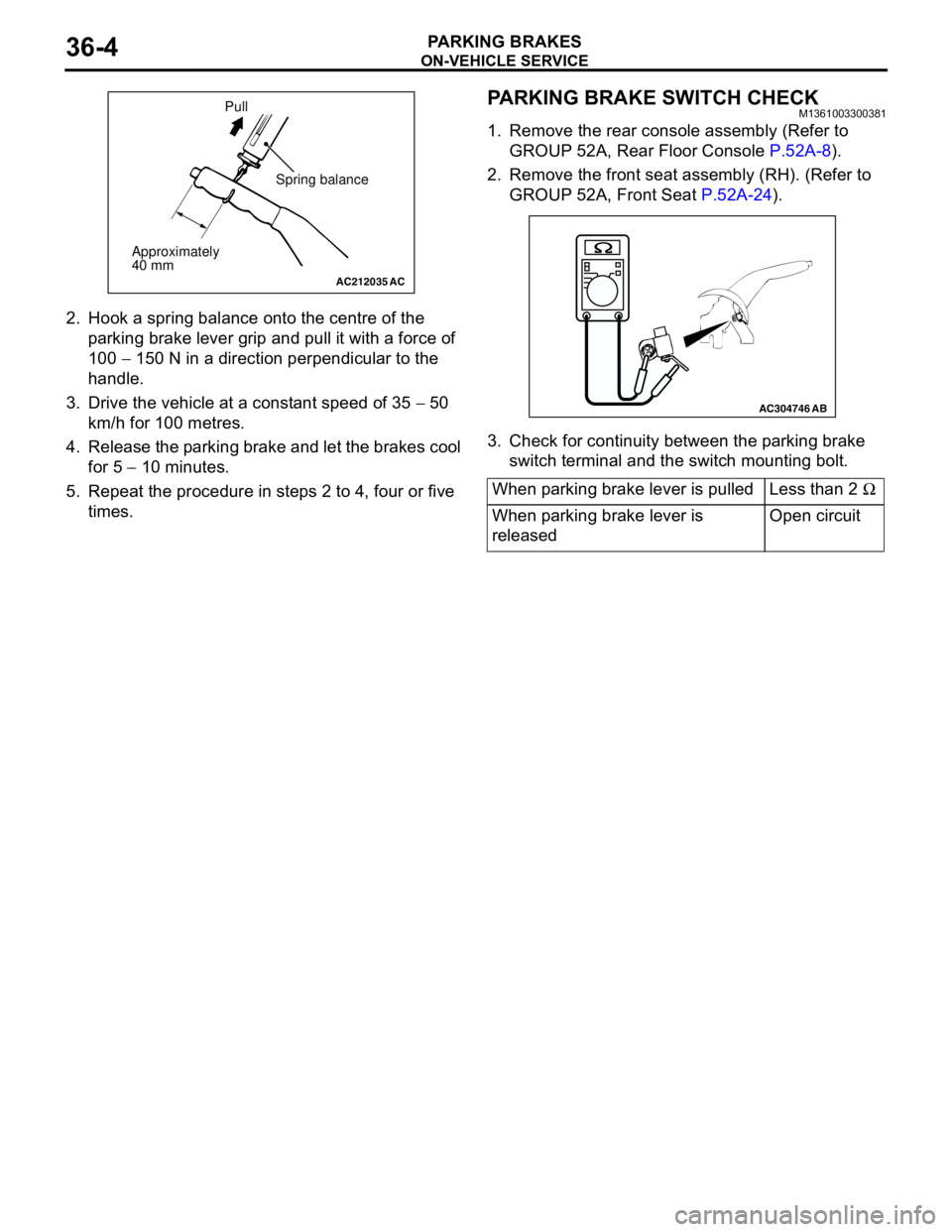
ON-VEHICLE SERVICE
PARKING BRAKES36-4
2. Hook a spring balance onto the centre of the
parking brake lever grip and pull it with a force of
100 − 150 N in a direction perpendicular to the
handle.
3. Drive the vehicle at a constant speed of 35 − 50
km/h for 100 metres.
4. Release the parking brake and let the brakes cool
for 5 − 10 minutes.
5. Repeat the procedure in steps 2 to 4, four or five
times.
PARKING BRAKE SWITCH CHECKM1361003300381
1. Remove the rear console assembly (Refer to
GROUP 52A, Rear Floor Console P.52A-8).
2. Remove the front seat assembly (RH). (Refer to
GROUP 52A, Front Seat P.52A-24).
3. Check for continuity between the parking brake
switch terminal and the switch mounting bolt.
AC212035AC
Spring balance
Approximately
40 mmPull
When parking brake lever is pulled Less than 2 Ω
When parking brake lever is
releasedOpen circuit
AC304746AB
Page 232 of 788
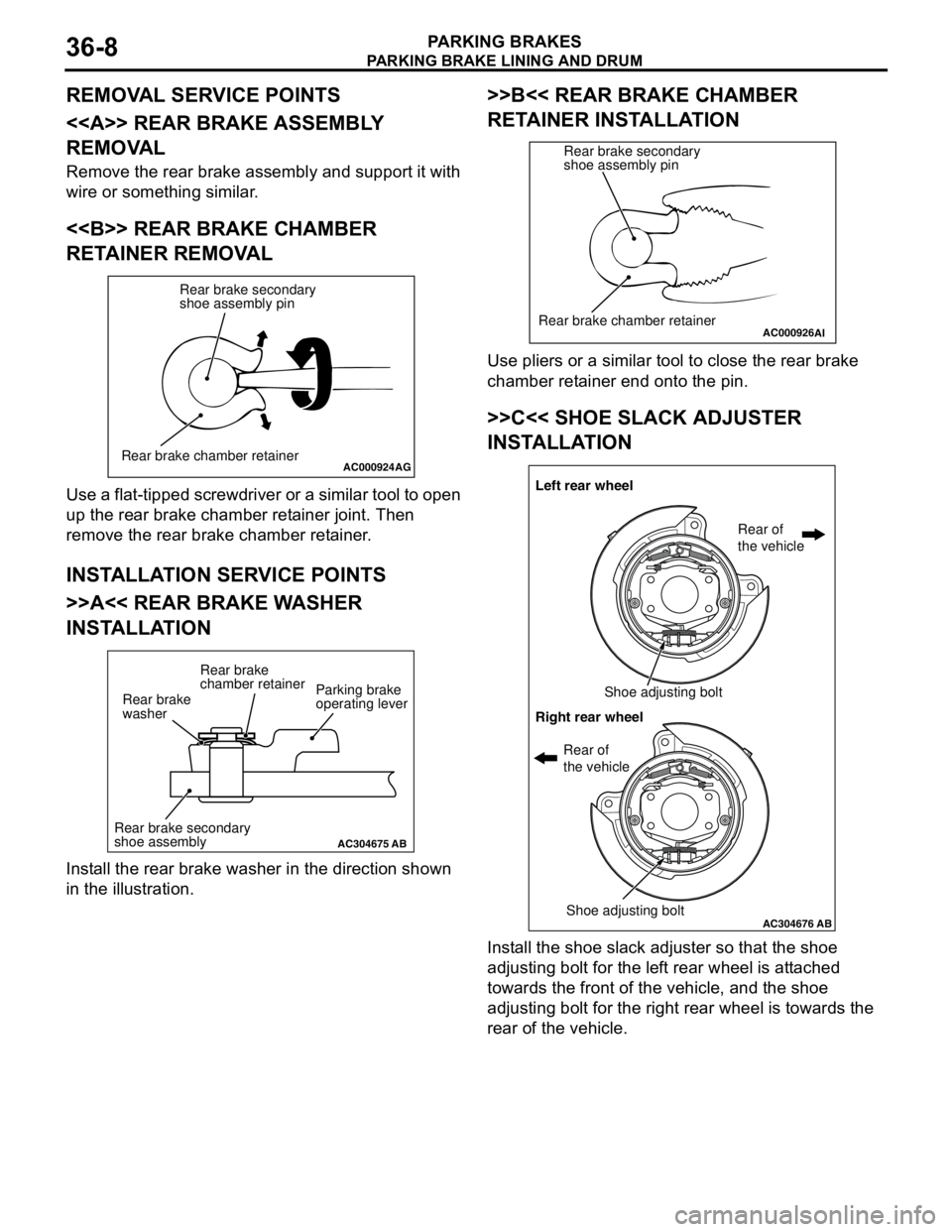
Page 245 of 788
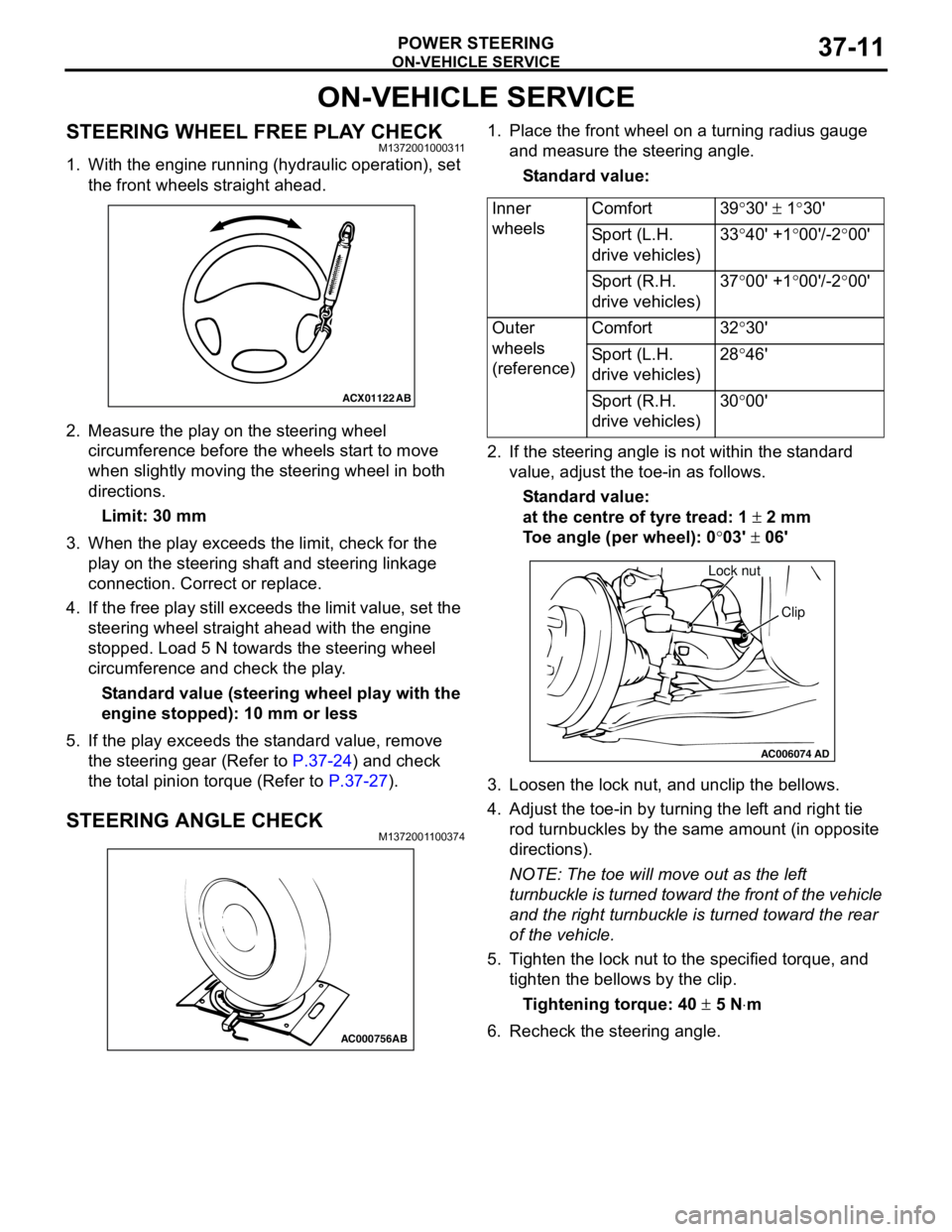
ON-VEHICLE SERVICE
POWER STEERING37-11
ON-VEHICLE SERVICE
STEERING WHEEL FREE PLAY CHECKM1372001000311
1. With the engine running (hydraulic operation), set
the front wheels straight ahead.
2. Measure the play on the steering wheel
circumference before the wheels start to move
when slightly moving the steering wheel in both
directions.
Limit: 30 mm
3. When the play exceeds the limit, check for the
play on the steering shaft and steering linkage
connection. Correct or replace.
4. If the free play still exceeds the limit value, set the
steering wheel straight ahead with the engine
stopped. Load 5 N towards the steering wheel
circumference and check the play.
Standard value (steering wheel play with the
engine stopped): 10 mm or less
5. If the play exceeds the standard value, remove
the steering gear (Refer to P.37-24) and check
the total pinion torque (Refer to P.37-27).
STEERING ANGLE CHECKM1372001100374
1. Place the front wheel on a turning radius gauge
and measure the steering angle.
Standard value:
2. If the steering angle is not within the standard
value, adjust the toe-in as follows.
Standard value:
at the centre of tyre tread: 1 ± 2 mm
Toe angle (per wheel): 0°03' ± 06'
3. Loosen the lock nut, and unclip the bellows.
4. Adjust the toe-in by turning the left and right tie
rod turnbuckles by the same amount (in opposite
directions).
NOTE: The toe will move out as the left
turnbuckle is turned toward the front of the vehicle
and the right turnbuckle is turned toward the rear
of the vehicle.
5. Tighten the lock nut to the specified torque, and
tighten the bellows by the clip.
Tightening torque: 40 ± 5 N⋅m
6. Recheck the steering angle.
ACX01122
AB
AC000756AB
Inner
wheelsComfort 39°30' ± 1°30'
Sport (L.H.
drive vehicles)33°40' +1°00'/-2°00'
Sport (R.H.
drive vehicles)37°00' +1°00'/-2°00'
Outer
wheels
(reference)Comfort 32°30'
Sport (L.H.
drive vehicles)28°46'
Sport (R.H.
drive vehicles)30°00'
AC006074AD
Lock nut
Clip
Page 252 of 788
